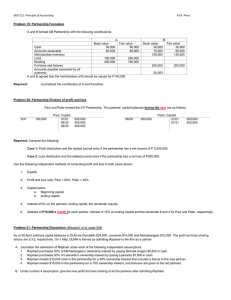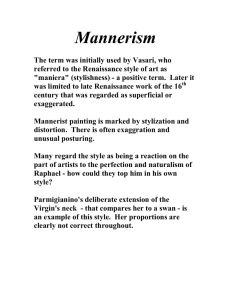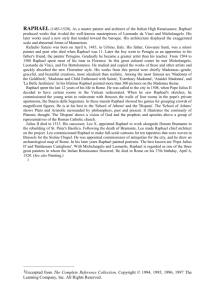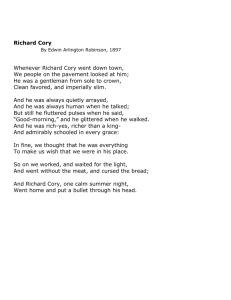ON ESSENTIAL RING EMBEDDINGS AND THE EPIMORPHIC C R. RAPHAEL, R.G. WOODS
advertisement
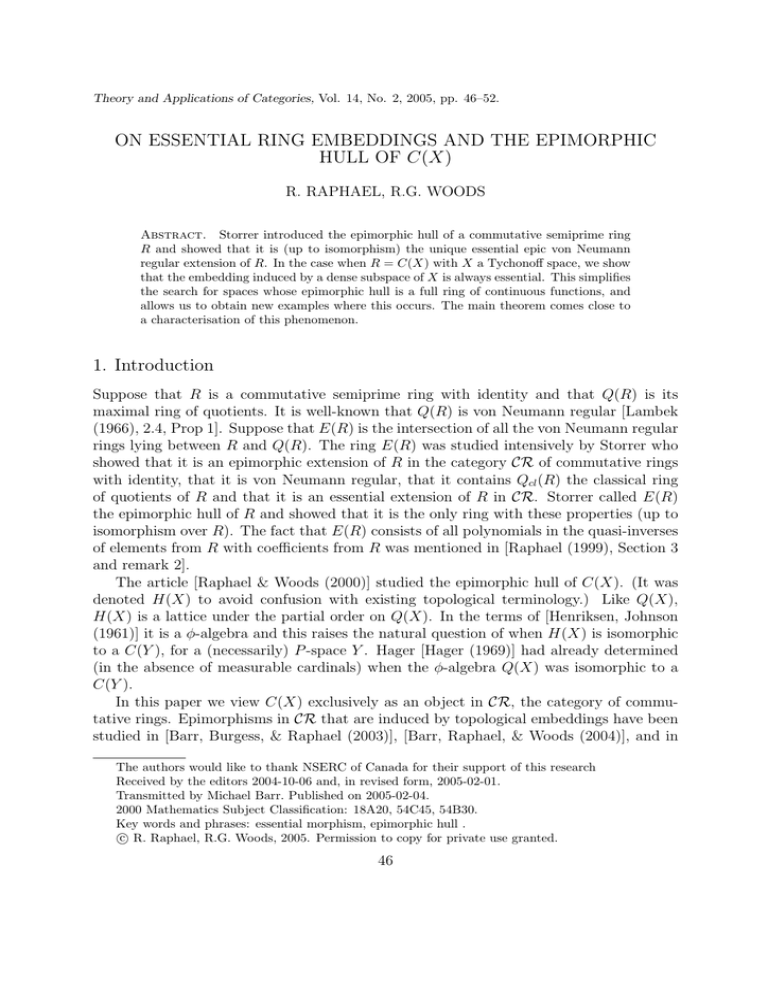
Theory and Applications of Categories, Vol. 14, No. 2, 2005, pp. 46–52.
ON ESSENTIAL RING EMBEDDINGS AND THE EPIMORPHIC
HULL OF C(X)
R. RAPHAEL, R.G. WOODS
Abstract. Storrer introduced the epimorphic hull of a commutative semiprime ring
R and showed that it is (up to isomorphism) the unique essential epic von Neumann
regular extension of R. In the case when R = C(X) with X a Tychonoff space, we show
that the embedding induced by a dense subspace of X is always essential. This simplifies
the search for spaces whose epimorphic hull is a full ring of continuous functions, and
allows us to obtain new examples where this occurs. The main theorem comes close to
a characterisation of this phenomenon.
1. Introduction
Suppose that R is a commutative semiprime ring with identity and that Q(R) is its
maximal ring of quotients. It is well-known that Q(R) is von Neumann regular [Lambek
(1966), 2.4, Prop 1]. Suppose that E(R) is the intersection of all the von Neumann regular
rings lying between R and Q(R). The ring E(R) was studied intensively by Storrer who
showed that it is an epimorphic extension of R in the category CR of commutative rings
with identity, that it is von Neumann regular, that it contains Qcl (R) the classical ring
of quotients of R and that it is an essential extension of R in CR. Storrer called E(R)
the epimorphic hull of R and showed that it is the only ring with these properties (up to
isomorphism over R). The fact that E(R) consists of all polynomials in the quasi-inverses
of elements from R with coefficients from R was mentioned in [Raphael (1999), Section 3
and remark 2].
The article [Raphael & Woods (2000)] studied the epimorphic hull of C(X). (It was
denoted H(X) to avoid confusion with existing topological terminology.) Like Q(X),
H(X) is a lattice under the partial order on Q(X). In the terms of [Henriksen, Johnson
(1961)] it is a φ-algebra and this raises the natural question of when H(X) is isomorphic
to a C(Y ), for a (necessarily) P -space Y . Hager [Hager (1969)] had already determined
(in the absence of measurable cardinals) when the φ-algebra Q(X) was isomorphic to a
C(Y ).
In this paper we view C(X) exclusively as an object in CR, the category of commutative rings. Epimorphisms in CR that are induced by topological embeddings have been
studied in [Barr, Burgess, & Raphael (2003)], [Barr, Raphael, & Woods (2004)], and in
The authors would like to thank NSERC of Canada for their support of this research
Received by the editors 2004-10-06 and, in revised form, 2005-02-01.
Transmitted by Michael Barr. Published on 2005-02-04.
2000 Mathematics Subject Classification: 18A20, 54C45, 54B30.
Key words and phrases: essential morphism, epimorphic hull .
c R. Raphael, R.G. Woods, 2005. Permission to copy for private use granted.
46
ON ESSENTIAL RING EMBEDDINGS AND THE EPIMORPHIC HULL OF C(X)
47
[Barr, Kennison, & Raphael (2004)]. We recall some notions. An inclusion X → Y is
called a CR-epic embedding if the map C(Y ) → C(X) induced by restriction is an
epimorphism in CR. The space X is called absolute CR-epic if every embedding of X
into any space Y is CR-epic.
1.1. Notation.
All spaces considered in this paper are assumed to be Tychonoff
(completely regular Hausdorff) and all functions, unless explicitly stated otherwise, are
assumed continuous. We denote by υX the Hewitt realcompactification of a Tychonoff
space X; see Chapter 8 of [Gillman & Jerison (1960)] or 5.5(c) and 5.10 of [Porter &
Woods (1988)] for background. We denote by gX the intersection of the dense cozero-sets
of X; see [Raphael & Woods (2000)] and [Raphael & Woods (2004)] for some elementary
properties of gX.
2. Essentiality in CR and topological embeddings
Recall that in any category a monic α is called essential if for all β, β ◦ α monic implies
β is monic. The classical example of essential extensions was in module theory but there
have been other instances of interest. It is easy to verify that a ring extension of a field
is essential in the category CR if and only if the extension is a field. Thus, another way
of saying that a field extension L of K is algebraic is to say that each ring between L and
K is an essential extension of K. These ideas were pursued in [Raphael (1970)] to get an
algebraic closure for commutative semiprime rings.
Given the unlikelihood of a monic being essential in CR, the following result is somewhat surprising:
2.1. Theorem.
Let X be a subspace of Y . If k ∈ C(X), k = 0, then there exist
functions h ∈ C(X), m ∈ C(Y ) such that kh = m|X = 0. In particular if X is dense in
Y , then the induced monic C(Y ) → C(X) is essential in CR.
Proof. Take k ∈ C(X), k = 0. There is a closed subset A ⊆ Y such that A∩X = Z(k).
Take p ∈ coz(k). By complete regularity there is a t ∈ C(Y ), 0 ≤ t ≤ 1 so that t(A) = 0
and t(p) = 1. There is a function m ∈ C(Y ) such that Z(m) = t−1 [0, 1/2]. Now Z[m|X]
is an X-neighbourhood of Z(k), so by [Gillman & Jerison (1960), 1D.1], m|X = kh for
some h ∈ C(X). Also m|X = 0 since p ∈
/ Z(m).
2.2. Remark. A space X is called a P -space if each zero-set is open and is called an
almost-P -space if each non-empty zero-set has non-empty interior (cf [Levy (1977)]). By
Xδ we will mean the (generally stronger) topology on X that is generated by declaring that
all zero-sets of X are open. The space Xδ is a P -space. The same topology is generated
by asking that all Gδ sets in X are open. In [Raphael & Woods (2000), 4.5] it was shown
that it is precisely for the almost-P -spaces X, that the embedding C(X) → C(Xδ ) is a
ring of quotients. An easy argument as in [Raphael & Woods (2000), 4.3] shows that this
is equivalent to the (weaker) demand that C(X) → C(Xδ ) be essential in CR.
48
R. RAPHAEL, R.G. WOODS
3. Applications to the epimorphic hull of C(X)
The main goal of [Raphael & Woods (2000)] was to characterize spaces X for which the
epimorphic hull H(X) of C(X) is a ring of continuous functions. The following (almost)
completes this goal. It generalizes [Raphael & Woods (2000), 5.16 and 5.17] and provides
additional examples of spaces where the epimorphic hull is a ring of functions. In [Raphael
& Woods (2000), section 5] an algebra G(X) was defined for an arbitrary Tychonoff space
X. The ring G(X) is von Neumann regular and is an epimorphic extension of C(X) in
CR. A space X is called RG [Henriksen, Raphael, & Woods (2001), 1.2] if G(X) = C(Xδ ).
It is clear that X is RG if and only if the embedding C(X) → C(Xδ ) is epic in CR.
3.1. Theorem.
(i) If K densely and epically contains an almost-P space X that is RG , then H(K) is
a ring of functions, namely C(Xδ ).
(ii) (partial converse) if H(K) is a ring of functions then K densely contains an almostP -space that is RG.
Proof.
(i) Let X be a dense absolute CR-epic almost-P , RG subspace of K. The induced
map C(K) → C(X) is essential by 2.1 and it is epi by assumption. The map
C(X) → C(Xδ ) is essential since X is almost-P and is epi because X is RG. Thus
C(Xδ ) = H(K) by [Storrer (1968), 11.2].
(ii) If H(K) is a ring of functions gK is a dense almost-P -space by [Raphael & Woods
(2000), 4.9 and 4.11]. Also by [Raphael & Woods (2000), 4.12] H(K) = C((gK)δ ).
Now the epi from C(K) into C((gK)δ ) factors through C(gK), so C(gK) → C((gK)δ )
is epi which makes gK an RG space.
3.2. Remark. Example 6.4 of [Storrer (1968)] shows that gK can be a dense almostP -subspace of K without being CR-epic in K.
3.3. Corollary. If K densely contains an almost-P , absolute CR-epic, RG space X
then H(K) = C(Xδ ). In particular this holds if X is a Lindelöf P -space or an RG space
that is almost-P , locally compact and σ-compact. A non realcompact example is given by
an almost compact, almost-P -space that is RG but not compact .
3.4. Remark. There are many examples of Lindelöf P -spaces — an example without
isolated points is given in [Henriksen, Raphael, & Woods (2001), 3.11]. The σ-compact
space T of [Raphael & Woods (2000), 6.2] is absolute CR-epic almost-P and RG, but not
a P -space. One can also get a realcompact candidate for the space X of the corollary
that is almost-P absolute CR-epic, RG but neither a Lindelöf P -space space, nor a locally
compact σ-compact space via a product as follows: let D be an uncountable discrete set,
ON ESSENTIAL RING EMBEDDINGS AND THE EPIMORPHIC HULL OF C(X)
49
let L = D ∪ {p} be its one-point Lindelofization, and let D∗ = D ∪ {ω} be its one-point
compactification. Then the product X = L × D∗ clearly fails to be a P -space, or a σcompact space. It also fails to be locally compact at the points of L × ω. However X is
an RG-space by [Henriksen, Raphael, & Woods (2001), 2.11(a)], it is absolute CR-epic by
[Barr, Kennison, & Raphael (2004), 3.4 and 4.6] and it is almost-P because any zero-set
of D∗ that contains ω is a co-countable subset of D∗ , and hence contains uncountably
many isolated points.
For the third example recall that a space X is called almost compact if |βX \ X| ≤ 1
[Gillman & Jerison (1960), 6J]. Almost compact spaces are easily seen to be absolute CRepic [Barr, Raphael, & Woods (2004)]. The existence of non-compact, almost compact,
almost-P RG-spaces was established in [Hrusak, Raphael, & Woods (2004), Theorem 6].
3.5. Remark.
In contrast to the results for P -spaces, there are many Lindelöf
almost-P -spaces that are not absolute CR-epic. Recent unpublished work in connection
with [Barr, Kennison, & Raphael (2004)] showed that any countable Tychonoff space is
homeomorphic to a closed subspace of a Lindelöf almost-P -space and that the latter is
absolute CR-epic if the former is. Thus there is, for example, a Lindelöf almost-P -space
containing the rationals and it is not absolute CR-epic.
3.6. Lemma.
Suppose that K is a space that contains a dense z-embedded almostP -space X. Then C(X) and C(gK) are naturally isomorphic. If K is realcompact then
gK = υX. Furthermore C(X) contains the classical ring of quotients Qcl (K) of C(K)
and the two rings have the same idempotents.
Proof. As noted in [Raphael & Woods (2000), 4.9] X ⊂ gK since gK is the largest
almost-P subspace of K. Since X is z-embedded in K [Blair & Hager (1974), 2.4] applies
and each function on X can be extended to a countable intersection of dense cozero-sets
of K. Thus each function on X extends to gK because it is the intersection of all the
dense cozero-sets of K. So X is C-embedded in gK and by the denseness of X in gK
C(X) and C(gK) are naturally isomorphic. In the case when K is realcompact, so are
its cozero sets and their intersection gK. Thus gK = υX.
It is well-known (cf [Fine, Gillman, & Lambek (1965)]) that Qcl (K) is the ring of
(equivalence classes) of functions on the dense cozero-sets of K. Thus each function in
Qcl (K) is defined on gX by restriction and Qcl (K) is a subring of C(gK). Finally let e
be an idempotent in C(X) whose zero-set is B and cozero-set is A. Both A and B are
cozero-sets in X and since X is z-embedded in K there are cozero-sets C and D of K
such that A = X ∩ C and B = X ∩ D. Since X is dense in K, C and D are disjoint.
If one defines a function to be 1 on C and 0 on D, then one has an extension of e to an
idempotent defined on a dense cozero-set of K, an element of Qcl (K).
Now we consider the case where X is a P -space.
3.7. Theorem.
Suppose that K is a space that has a dense CR-epic P -subspace X.
Then gK is a P -space and the rings H(K), C(gK) and Qcl (K) coincide. In particular
this holds if X is a dense Lindelöf P -subspace of K.
50
R. RAPHAEL, R.G. WOODS
Proof. Since X is a CR-epic P -subspace of K it is z-embedded in K by [Barr, Raphael,
& Woods (2004), Lemma 5.1]. By theorem 3.1 and lemma 3.6 we have C(K) → Qcl (K) →
C(gK) = C(X) = H(K). Thus gK is a P -space. It is easy to see that H(K) = Qcl (K)
because algebraically one gets H(K) by adjoining to C(K) the idempotents of H(K) and
then taking the classical ring of quotients of the resulting ring. By lemma 3.6 the ring
Qcl (K) already contains these idempotents and is its own classical ring of quotients.
3.8. Remark. While on the topic of epimorphic hulls we note that [Raphael & Woods
(2000), Lemma 5.14] holds without assuming the realcompactness of X. As a consequence
Lemma 5.15 and Theorems 5.16, and 5.17 of [Raphael & Woods (2000)] also hold without
the assumption of realcompactness. This assertion follows once one has established the
following:
3.9. Claim.
Let T be Lindelöf and almost-P . If T is dense in the Tychonoff space
X, then gX = T .
Proof.
Since T is a dense almost-P -subspace, T lies in gX by [Raphael & Woods
(2000), 4.9]. Thus it lies in every dense cozero-set of X. Conversely, if p ∈ X − T , for
each x ∈ T there is a cozero-set of X that contains x but not p. These cover T . As T is
Lindelöf there is a countable subfamily that covers T with union W (p), say. Then W (p)
is a dense cozero-set of X not containing p and thus p ∈
/ gX. It follows that T = gX.
Note that T is realcompact because it is Lindelof.
We note that [Henriksen, Raphael, & Woods (2001), Cor 4.12] is missing the assumption that X and Y are realcompact.
4. Some examples
1. The condition in part (ii) of theorem 3.1 is not sufficient to imply that the embedding
gK → K is CR-epic, i.e. this can fail to occur even if K has a dense almost-P subspace
that is RG. A compact example is provided by the Alexandroff double K = A(M ) of
[Raphael & Woods (2000), Example 6.4]. As shown in the example H(K) is not a ring
of functions. Hence by part (i) of theorem 3.1 the embedding gK → K is not CR-epic.
Interestingly, gK is a P -space in this case.
2. There exists a Lindelof almost-P space that is scattered of finite Cantor Bendixon
index and not absolute CR-epic. An example can be constructed as follows. Let Y be a
metric space that is countable, scattered, of finite Cantor Bendixon index, and not locally
compact. (An easy example is given in [Barr, Burgess, & Raphael (2003)]). Note that
since Y is not locally compact it is not absolute CR-epic by [Barr, Raphael, & Woods
(2004), 2.27]. Now let X be the space mentioned in Remark 3.5 constructed on the
(set) product of Y and the one point Lindelofization of an uncountable discrete set. The
space X is almost-P and Lindelof scattered of finite Cantor Bendixon index. It follows
by [Henriksen, Raphael, & Woods (2001), 2.12] that X is also RG. However by [Barr,
ON ESSENTIAL RING EMBEDDINGS AND THE EPIMORPHIC HULL OF C(X)
51
Kennison, & Raphael (2004), 6.4 ] X is not absolute CR-epic because it has a closed
subspace that is not absolute CR-epic, namely Y .
3. The space X of example 2 provides a “smaller” example of the phenomenon discussed in example 1. Since X is not absolute CR-epic it has a compactifcation K for which
the embedding X → K is not CR-epic. And by Claim 3.9 gK = X, an almostP RG-space.
5. Question
If H(K) is a ring of functions then must the map C(K) → C(gK) be epic? If so, then the
condition in part (i) of theorem 3.1 is necessary and sufficient. There is a counterexample
if the space X of example 2 is dense and not CR-epic in an ambient RG-space K.
References
M. Barr, W. Burgess and R. Raphael (2003), Ring epimorphisms and C(X). Theory and
Applications of Categories 11, 283–308.
M. Barr, J. F. Kennison, and R. Raphael (2004), Searching for absolute CR-epic spaces.
(submitted).
M. Barr, R. Raphael, and R.G. Woods (2004), On CR-epic embeddings and absolute
CR-epic spaces. Canadian Journal of Mathematics (to appear).
R.L. Blair and A.W. Hager (1974), Extensions of zero-sets and real-valued functions.
Math. Zeit. 136, 41–52.
N. Fine, L. Gillman and J. Lambek (1965), Rings of Quotients of Rings of Functions.
McGill University Press, Montreal.
L. Gillman and M. Jerison (1960), Rings of Continuous Functions. D. Van Nostrand,
Princeton.
A.W. Hager (1969) , Isomorphism with a C(Y ) of the maximal ring of quotients of C(X).
Fund. Math. 66, 7–13.
M. Henriksen, R. Raphael and R.G. Woods (2002), A minimal regular ring extension of
C(X). Fund. Math. 172, 1–17.
M. Henriksen, D.G. Johnson (1961), On the structure of a class of archimedian latticeordered algeras . Fund. Math. 1961, 73–94.
M. Hrusak, R. Raphael and R.G. Woods (2004), On a class of pseudocompact spaces
derived from ring epimorphisms.
J.Lambek (1966), Lectures on Rings and Modules. Blaisdell.
52
R. RAPHAEL, R.G. WOODS
R. Levy (1977), Almost P -spaces. Can. J. Math., 29, 284–288.
J.R. Porter and R.G. Woods (1988), Extensions and Absolutes of Hausdorff Spaces.
Springer-Verlag, New York.
R. Raphael (1970), Algebraic extensions of commutative regular rings, Can. J. Math. .
22, 1133-1155.
R. Raphael and R.G. Woods (2000), The epimorphic hull of C(X), Topology Appl. 105,
65–88.
R. Raphael and R.G. Woods (2004), On RG-spaces and the regularity degree, (submitted).
R. Raphael (1999), Some regular epimorphic contexts, Theory and Applications of Categories. 6 94–104.
H. Storrer (1968), Epimorphismen von kommutativen Ringen. Comm. Math. Helv. 43,
378–401.
Department of Mathematics and Statistics
Concordia University, Montreal, QC, H4B 1R6
Department of Mathematics, University of Manitoba
Winnipeg, MN, R3T 2N2
Email: raphael@alcor.concordia.ca
rgwoods@cc.umanitoba.ca
This article may be accessed via WWW at http://www.tac.mta.ca/tac/ or by anonymous ftp at ftp://ftp.tac.mta.ca/pub/tac/html/volumes/14/2/14-02.{dvi,ps}
THEORY AND APPLICATIONS OF CATEGORIES (ISSN 1201-561X) will disseminate articles that
significantly advance the study of categorical algebra or methods, or that make significant new contributions to mathematical science using categorical methods. The scope of the journal includes: all areas of
pure category theory, including higher dimensional categories; applications of category theory to algebra,
geometry and topology and other areas of mathematics; applications of category theory to computer
science, physics and other mathematical sciences; contributions to scientific knowledge that make use of
categorical methods.
Articles appearing in the journal have been carefully and critically refereed under the responsibility
of members of the Editorial Board. Only papers judged to be both significant and excellent are accepted
for publication.
The method of distribution of the journal is via the Internet tools WWW/ftp. The journal is archived
electronically and in printed paper format.
Subscription information. Individual subscribers receive (by e-mail) abstracts of articles as
they are published. Full text of published articles is available in .dvi, Postscript and PDF. Details will
be e-mailed to new subscribers. To subscribe, send e-mail to tac@mta.ca including a full name and
postal address. For institutional subscription, send enquiries to the Managing Editor, Robert Rosebrugh,
rrosebrugh@mta.ca.
The typesetting language of the journal is TEX, and LATEX2e is
the preferred flavour. TEX source of articles for publication should be submitted by e-mail directly to
an appropriate Editor. They are listed below. Please obtain detailed information on submission format
and style files from the journal’s WWW server at http://www.tac.mta.ca/tac/. You may also write
to tac@mta.ca to receive details by e-mail.
Information for authors.
Managing editor. Robert Rosebrugh, Mount Allison University: rrosebrugh@mta.ca
TEXnical editor. Michael Barr, McGill University: barr@barrs.org
Transmitting editors.
Lawrence Breen, Université Paris 13: breen@math.univ-paris13.fr
Ronald Brown, University of North Wales: r.brown@bangor.ac.uk
Jean-Luc Brylinski, Pennsylvania State University: jlb@math.psu.edu
Aurelio Carboni, Università dell Insubria: aurelio.carboni@uninsubria.it
Valeria de Paiva, Xerox Palo Alto Research Center: paiva@parc.xerox.com
Martin Hyland, University of Cambridge: M.Hyland@dpmms.cam.ac.uk
P. T. Johnstone, University of Cambridge: ptj@dpmms.cam.ac.uk
G. Max Kelly, University of Sydney: maxk@maths.usyd.edu.au
Anders Kock, University of Aarhus: kock@imf.au.dk
Stephen Lack, University of Western Sydney: s.lack@uws.edu.au
F. William Lawvere, State University of New York at Buffalo: wlawvere@acsu.buffalo.edu
Jean-Louis Loday, Université de Strasbourg: loday@math.u-strasbg.fr
Ieke Moerdijk, University of Utrecht: moerdijk@math.uu.nl
Susan Niefield, Union College: niefiels@union.edu
Robert Paré, Dalhousie University: pare@mathstat.dal.ca
Jiri Rosicky, Masaryk University: rosicky@math.muni.cz
James Stasheff, University of North Carolina: jds@math.unc.edu
Ross Street, Macquarie University: street@math.mq.edu.au
Walter Tholen, York University: tholen@mathstat.yorku.ca
Myles Tierney, Rutgers University: tierney@math.rutgers.edu
Robert F. C. Walters, University of Insubria: robert.walters@uninsubria.it
R. J. Wood, Dalhousie University: rjwood@mathstat.dal.ca
